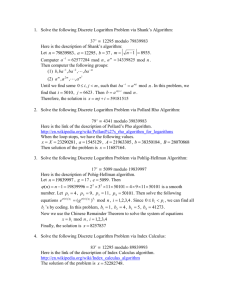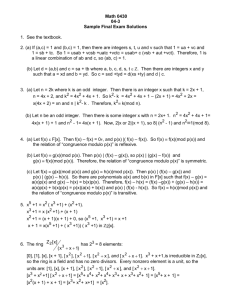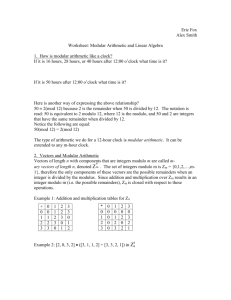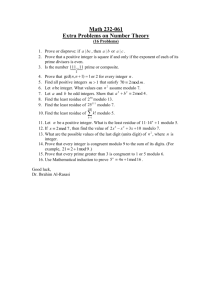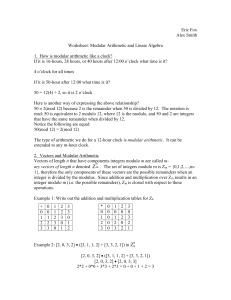PROBLEM SET # 2 SOLUTIONS 2.1 Groups. 1. Let G be a group
advertisement
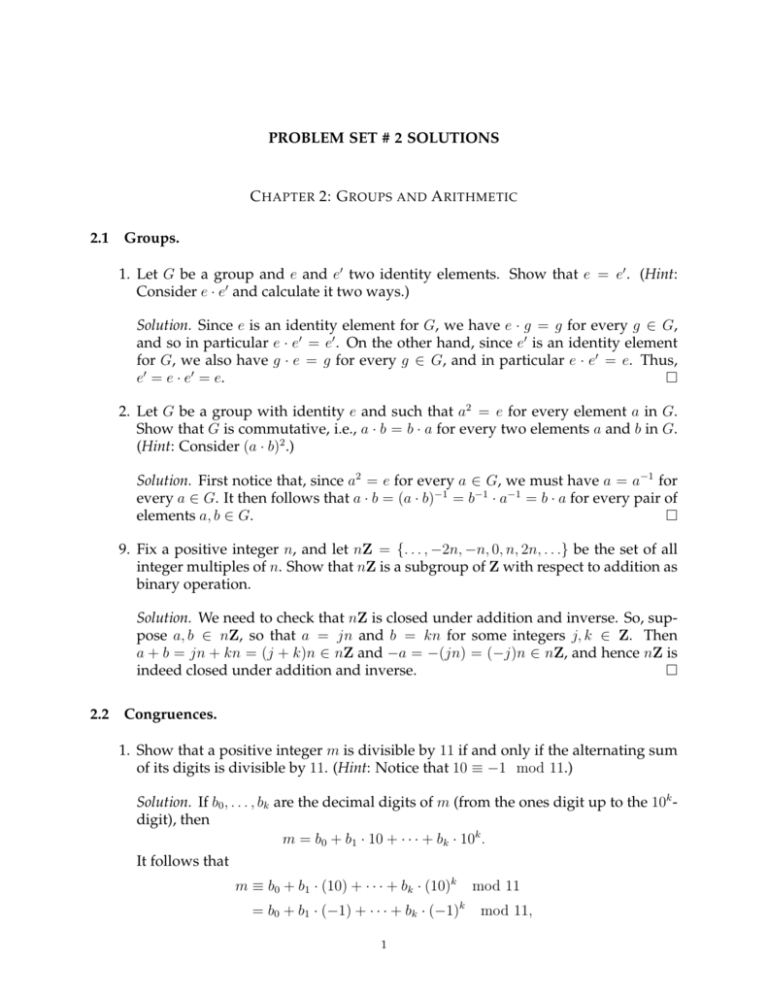
PROBLEM SET # 2 SOLUTIONS
C HAPTER 2: G ROUPS AND A RITHMETIC
2.1
Groups.
1. Let G be a group and e and e0 two identity elements. Show that e = e0 . (Hint:
Consider e · e0 and calculate it two ways.)
Solution. Since e is an identity element for G, we have e · g = g for every g ∈ G,
and so in particular e · e0 = e0 . On the other hand, since e0 is an identity element
for G, we also have g · e = g for every g ∈ G, and in particular e · e0 = e. Thus,
e0 = e · e0 = e.
2. Let G be a group with identity e and such that a2 = e for every element a in G.
Show that G is commutative, i.e., a · b = b · a for every two elements a and b in G.
(Hint: Consider (a · b)2 .)
Solution. First notice that, since a2 = e for every a ∈ G, we must have a = a−1 for
every a ∈ G. It then follows that a · b = (a · b)−1 = b−1 · a−1 = b · a for every pair of
elements a, b ∈ G.
9. Fix a positive integer n, and let nZ = {. . . , −2n, −n, 0, n, 2n, . . .} be the set of all
integer multiples of n. Show that nZ is a subgroup of Z with respect to addition as
binary operation.
Solution. We need to check that nZ is closed under addition and inverse. So, suppose a, b ∈ nZ, so that a = jn and b = kn for some integers j, k ∈ Z. Then
a + b = jn + kn = (j + k)n ∈ nZ and −a = −(jn) = (−j)n ∈ nZ, and hence nZ is
indeed closed under addition and inverse.
2.2
Congruences.
1. Show that a positive integer m is divisible by 11 if and only if the alternating sum
of its digits is divisible by 11. (Hint: Notice that 10 ≡ −1 mod 11.)
Solution. If b0 , . . . , bk are the decimal digits of m (from the ones digit up to the 10k digit), then
m = b0 + b1 · 10 + · · · + bk · 10k .
It follows that
m ≡ b0 + b1 · (10) + · · · + bk · (10)k
= b0 + b1 · (−1) + · · · + bk · (−1)k
1
mod 11
mod 11,
and so m is congruent (modulo 11) to the alternating sum of its digits. Thus, m is
divisible by 11 if and only if the alternating sum of its digits is.
2.3
Modular Arithmetic.
3. Write down the multiplication table for Z/11Z, the set of integers modulo 11. The
subset of invertible integers modulo 11 is denoted by (Z/11Z)× . Extract the multiplication table for (Z/11Z)× .
Solution. By a straightforward calculation, we find
·
0
1
2
3
4
5
6
7
8
9
10
0 1 2 3 4 5 6 7 8 9 10
0 0 0 0 0 0 0 0 0 0 0
0 1 2 3 4 5 6 7 8 9 10
0 2 4 6 8 10 1 3 5 7 9
0 3 6 9 1 4 7 10 2 5 8
0 4 8 1 5 9 2 6 10 3 7
0 5 10 4 9 3 8 2 7 1 6
0 6 1 7 2 8 3 9 4 10 5
0 7 3 10 6 2 9 5 1 8 4
0 8 5 2 10 7 4 1 9 6 3
0 9 7 5 3 1 10 8 6 4 2
0 10 9 8 7 6 5 4 3 2 1
From this table, we see that all of the nonzero elements of Z/11Z are invertible,
and the multiplication table for (Z/11Z)× is
· 1 2 3 4 5 6 7 8 9 10
1 1 2 3 4 5 6 7 8 9 10
2 2 4 6 8 10 1 3 5 7 9
3 3 6 9 1 4 7 10 2 5 8
4 4 8 1 5 9 2 6 10 3 7
5 5 10 4 9 3 8 2 7 1 6
6 6 1 7 2 8 3 9 4 10 5
7 7 3 10 6 2 9 5 1 8 4
8 8 5 2 10 7 4 1 9 6 3
9 9 7 5 3 1 10 8 6 4 2
10 10 9 8 7 6 5 4 3 2 1
4. Write down the multiplication table for Z/10Z, the set of integers modulo 10. The
subset of invertible integers modulo 10 is denoted by (Z/10Z)× . Extract the multiplication table for (Z/10Z)× . How many invertible elements do we have here?
Solution. By a straightforward calculation, we find
2
·
0
1
2
3
4
5
6
7
8
9
0
0
0
0
0
0
0
0
0
0
0
1
0
1
2
3
4
5
6
7
8
9
2
0
2
4
6
8
0
2
4
6
8
3
0
3
6
9
2
5
8
1
4
7
4
0
4
8
2
6
0
4
8
1
6
5
0
5
0
5
0
5
0
5
0
5
6
0
6
2
8
4
0
6
2
8
4
7
0
7
4
1
8
5
2
9
6
3
8
0
8
6
4
2
0
8
6
4
2
9
0
9
8
7
6
5
4
3
2
1
From this table, we see that the invertible elements of Z/10Z are 1, 3, 7, and 9, and
the the multiplication table for (Z/10Z)× is
·
1
3
7
9
1
1
3
7
9
3
3
9
1
7
7
7
1
9
3
9
9
7
3
1
5. Write down the multiplication table for Z/12Z, the set of integers modulo 12. The
subset of invertible integers modulo 12 is denoted by (Z/12Z)× . Extract the multiplication table for (Z/12Z)× . How many invertible elements do we have here?
Solution. By a straightforward calculation, we find
·
0
1
2
3
4
5
6
7
8
9
10
11
0 1 2
0 0 0
0 1 2
0 2 4
0 3 6
0 4 8
0 5 10
0 6 0
0 7 2
0 8 4
0 9 6
0 10 8
0 11 10
3
0
3
6
9
0
3
6
9
0
3
6
9
4 5 6 7 8 9 10 11
0 0 0 0 0 0 0 0
4 5 6 7 8 9 10 11
8 10 0 2 4 6 8 10
0 3 6 9 0 3 6 9
4 8 0 4 8 0 4 8
8 1 6 11 4 9 2 7
0 6 0 6 0 6 0 6
4 11 6 1 8 3 10 5
8 4 0 8 4 0 8 4
0 9 6 3 0 9 6 3
4 2 0 10 8 6 4 2
8 7 6 5 4 3 2 1
From this table, we see that the invertible elements of Z/12Z are 1, 5, 7, and 11, and
that the multiplication table for (Z/12Z)× is
3
· 1 5 7 11
1 1 5 7 11
5 5 1 11 7
7 7 11 1 5
11 11 7 5 1
6. Use the Euclidean algorithm to compute the multiplicative inverse of 131 modulo
1979.
Solution. We first run the Euclidean algorithm:
1979 = 15 · 131 + 4
131 = 9 · 14 + 5
14 = 2 · 5 + 4
5=1·4+1
4 = 4 · 1.
The second-to-last convergent in the continued fraction algorithm for 1979/131 is
therefore
423
1
.
=
15 +
1
28
9 + 2+ 1
1
Observe, then, that 1979 · 28 = 55412 and 131 · 423 = 55413, and so 1979 · (−28) +
131 · (423) = 1. Thus, the inverse of 131 modulo 1979 is 423.
7. Use the Euclidean algorithm to compute the multiplicative inverse of 127 modulo
1091.
Solution. We first run the Euclidean algorithm:
1091 = 8 · 127 + 75
127 = 1 · 75 + 52
75 = 1 · 52 + 23
52 = 2 · 23 + 6
23 = 3 · 6 + 5
6=1·5+1
5 = 5 · 1.
The second-to-last convergent in the continued fraction algorithm for 1091/127 is
therefore
1
189
8+
=
.
1
22
1 + 1+ 1
2+
1
3+ 1
1
Observe, then, that 1091 · 22 = 24002 and 127 · 189 = 24003, and so 1091 · (−22) +
127 · (189) = 1. Thus, the inverse of 127 modulo 1091 is 189.
4
2.4
Theorem of Lagrange.
1. Let G be a group and g an element in G of order n. Let m be a positive integer such
that g m = e. Show that n divides m. (Hint: Write m = qn + r with 0 ≤ r < n.)
Solution. Following the hint, we write m = qn + r with 0 ≤ r < n. Then observe
that
e = g m = g qn+r = (g n )q · g r = eq · g r = g r .
Since r < n and n is the order of g, we must therefore have r = 0. Thus m = qn,
and hence n divides m.
2. Repeat the argument of Lagrange’s theorem with G = (Z/13Z)× and g = 5.
Solution. Following the proof, we first note that the order of g = 5 is 4. We then
compute e, g, g 2 , g 3 . We obtain
e g g2 g3
1 5 12 8
We see that x = 2 is missing from the list. We then compute x, xg, xg 2 , xg 3 , finding
x xg xg 2 xg 3
2 10 11
3
We see that y = 4 has yet to appear in either of the above lists, so we next compute
y, yg, yg 2 , yg 4 , finding
y yg yg 2 yg 3
4 7
9
6
Looking over the three lists of numbers, we see that we have now accounted for
every element of G exactly once, and that 12 = |G| = 3 · 4 = 3 · ord(g), i.e., org(g)
divides |G|.
2.5
Chinese Remainder Theorem.
X
2. Put φ(1) = 1. Compute
φ(d).
d|1000
Solution. Since 1000 = 23 ·33 , the set of divisors of 1000 is {1, 2, 2·3, 2·32 , 2·33 , 22 , 22 ·
3, 22 ·32 , 22 ·33 , 23 , 23 ·3, 23 ·32 , 23 ·33 }. We therefore have (using our known properties
of φ)
X
φ(d) = φ(1) + φ(2) + · · · + φ(2 · 33 ) + φ(22 ) + · · · + φ(22 · 33 ) + φ(23 ) + · · · + φ(23 · 33 )
d|1000
= φ(1) + φ(2) + φ(22 ) + φ(23 ) φ(1) + φ(3) + φ(32 ) + φ(33 )
= 1 + (2 − 1) + (22 − 2) + (23 − 22 ) 1 + (3 − 1) + (32 − 3) + (33 − 32 )
= 23 · 33
= 1000.
5
(Can you see how to prove the equality
X
φ(d) = n in general?)
d|n
3. Solve the system of congruences
x≡5
x≡7
mod 11
mod 13.
Solution. We follow the notation used in lecture. By a simple calculation, one can
easily check that y1 = 6 is the inverse of M1 = 13 modulo m1 = 11, and that y2 = 6
is the inverse of M2 = 11 modulo m2 = 13. The solution to the system of equations
is therefore
x ≡ 5 · 13 · 6 + 7 · 11 · 6 mod (11 · 13),
which simplifies to x ≡ 137 mod 143.
4. Solve the system of congruences
x ≡ 11
x ≡ 16
mod 16
mod 27.
Solution. We follow the notation used in lecture. By a simple calculation, one can
easily check that y1 = 3 is the inverse of M1 = 27 modulo m1 = 16, and that y2 = 22
is the inverse of M2 = 16 modulo m2 = 27. The solution to the system of equations
is therefore
x ≡ 11 · 27 · 3 + 16 · 16 · 22 mod (16 · 27),
which simplifies to x ≡ 43 mod 432.
5. Find the last two digits of 29999 . Do not use a calculator.
Solution. Let x = 29999 . We wish to compute the remainder of x modulo 100 = 4·25.
We first observe that we obviously have x = 29999 ≡ 0 mod 4. Next observe that
210 ≡ −1 mod 25, and so
x = 29999 = (210 )999 · 29 ≡ (−1)999 · (512)
mod 25
≡ (−1) · (12) mod 25
≡ 13 mod 25.
We now wish to solve the system of equation
x ≡ 0 mod 4
x ≡ 13 mod 25.
By a simple calculation, we see that y1 = 1 is the inverse of M1 = 25 modulo
m1 = 4, and y2 = 19 is the inverse of M2 = 4 modulo m2 = 25. Thus, the solution
to this system of equations is
x ≡ 0 · 25 · 1 + 13 · 4 · 19
mod (4 · 25),
which simplifies to x ≡ 88 mod 100. Thus, the last two digits of x = 29999 are
88.
6


